Google Nexus 5 Review
by Brian Klug on December 5, 2013 8:00 AM EST- Posted in
- Smartphones
- LG
- Android
- Mobile
- Snapdragon 800
- Android 4.4
- Nexus 5
Display on mobile devices is one area where we’ve seen considerable improvement. Pixel density has gone up, contrast ratios have improved, and the emphasis on low power in a platform gated by its battery size means there’s always innovation happening.
In the case of the Nexus 5, there’s a considerable jump in resolution, from the WXGA 1280x768 display on the Nexus 4, to the now-standard 1080p. The biggest change is an obvious shift in aspect ratio from 15:9 to 16:9 once more. Back with the Nexus 4 and Optimus G, I noted just how surprisingly noticeable that extra 48 pixels of width was. Although we tend to think in absolute display resolution and talk about it quite a bit, Android uses display independent pixels or dips in order to keep layouts display density agnostic and support a wide variety of screen sizes and resolutions. Nexus 5 implements the 480 ppi or xxhdpi screen density, whereas Nexus 4 implements 320 ppi or xhdpi density. The result is that the Nexus 5’s display is 360x592 dips in size, compared to 384x592 dips for the Nexus 4, coming in 24 dips narrower. It’s important to note however that this change is intentional to maintain Android’s DPI independence, even if it does mean less overall real-estate in apps and browser.
Display quality is a big deal in the Android space, with lots of variance between devices. In the case of the Nexus 5, I started by tracking down the display type. If you recall, 5-inches with 1080p is a resolution we’ve seen before in the Droid DNA and Butterfly. From what I can tell, the Nexus 5 uses a very similar evolved version of that panel, a JDI (Japan Display, Inc) 1080p display with in-cell touch courtesy Synaptics ClearPad 3350 solution.
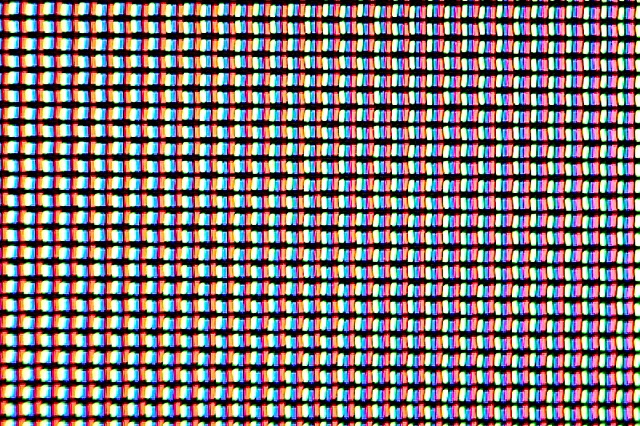
The other question was whether Nexus 5 also uses a PSR (Panel Self Refresh) type display. This display is indeed a MIPI command mode panel, the same kind of system, so yes it does include those features. An additional change is the addition of software vsync in Android 4.4, which to my knowledge the Nexus 5 does use, you can see this pop on and off depending on what’s happening on-screen if you monitor surfaceflinger. Those improvements should decrease latency and improve how sticky animations feel.
To characterize display quality and accuracy, we turn to our usual display measurements.
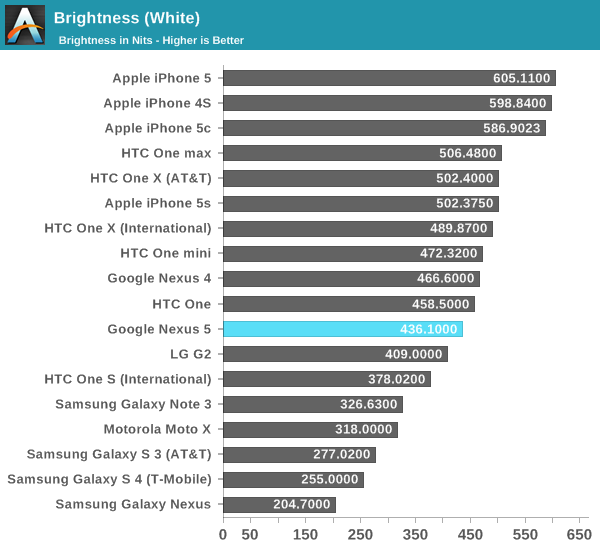
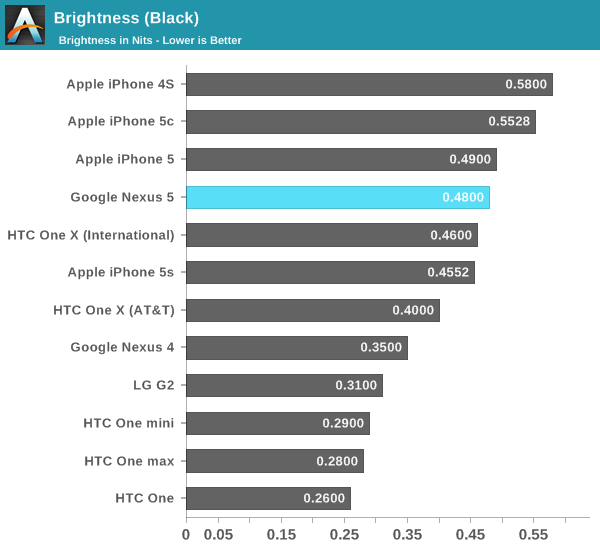
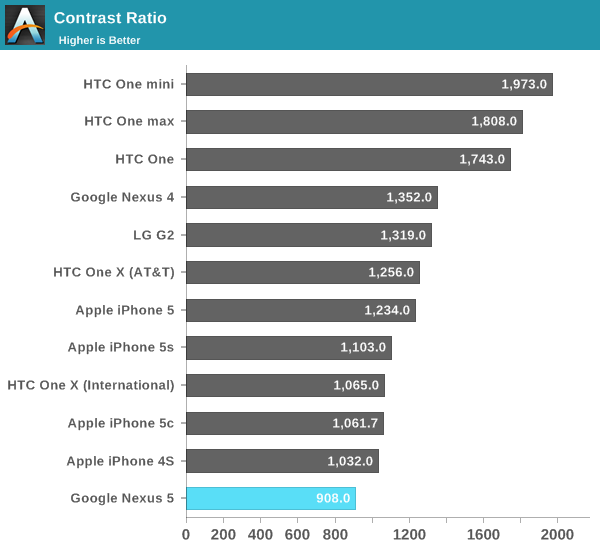
The Nexus 5 doesn’t go quite as bright as Nexus 4, but it’s still a very bright display. Blacks and contrast are a bit disappointing though, contrast is definitely on the lower end, but not bad. I definitely haven’t been put off by them. I also haven’t noticed any of the distracting dynamic brightness behavior I have on other handsets, which is awesome.
My only criticism is that I wish Nexus 5 would allow its auto screen brightness algorithm to go dimmer when in dark scenarios. There’s still more dynamic range in the manual brightness setting bar than there is for the auto brightness routine from what I can tell.

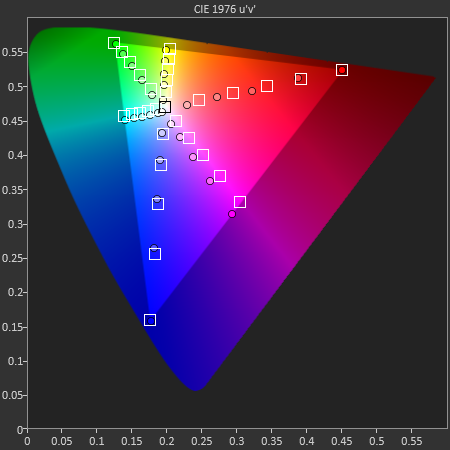
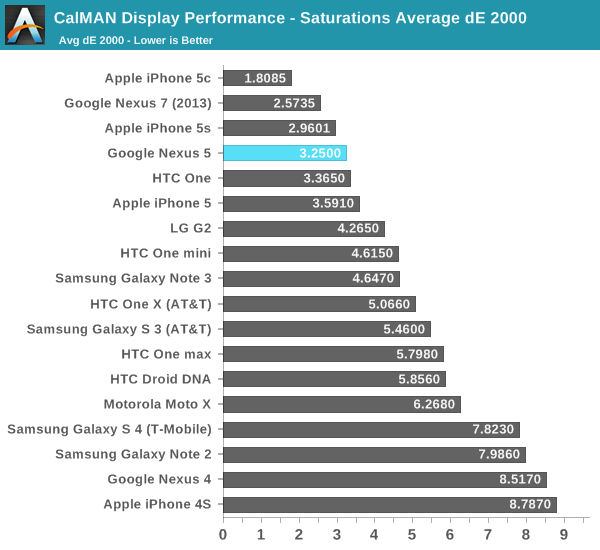
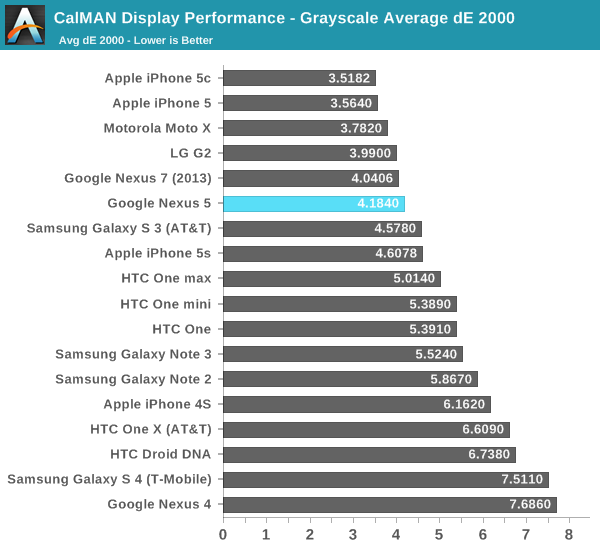
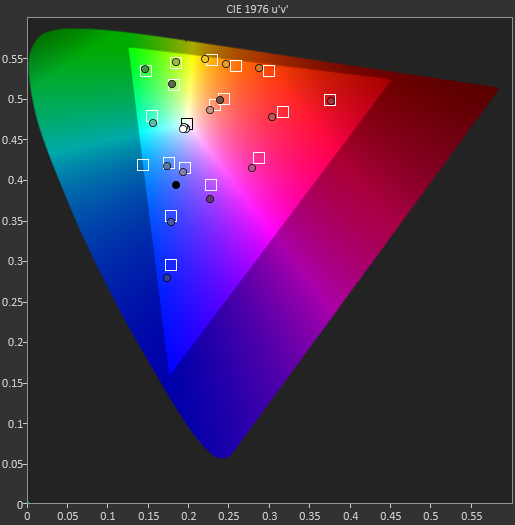
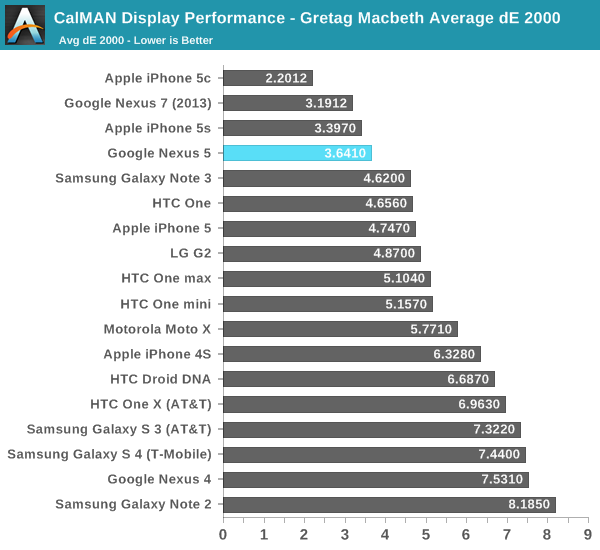
The new Nexus 7 impressed me with how accurate its display was in terms of color reproduction, beginning with Google stating it targeted sRGB (the color space for both the web and Android) calibration for it. The Nexus 5 seems to have done the same, and wowed me with the best GMB color checker Delta-Es we’ve seen from any Android handset. In addition, the Nexus 5 has none of the saturation boost that’s sadly quite pervasive right now, instead giving the right evenly spaced saturation stepping on its color channels. The Nexus 7 has slightly lower Delta-E, but it’s clear to me that Google has made color calibration an emphasis on the Nexus line.
It’s interesting to hear some Nexus 5 users complain that the display seems undersaturated, since that kind of end user feedback reflects subjective comparison. It also suggests to me that a large percentage of the population doesn’t know what some colors or system elements actually should be. Even for me, looking at the green elements inside the Google Play store on the Note 3 in movie mode or Nexus 5 initially seemed slightly more muted than normal. The reality is that this is what they actually should look like. We’ve just become accustomed to their oversaturated appearance on virtually every other device.
This kind of expectation about what looks right and what doesn’t is rather telling for the state of display calibration in Android handsets, and how OEMs have used oversaturated colors to increase retail shelf appeal. Unfortunately the reality is that oversaturated colors do seem to win taste tests among shoppers, the same way that TVs in most big boxes do. We’ve been looking at them for so long that well calibrated displays like Nexus 5 initially do look noticeably different.
The end result is easy to sum up, however – Nexus 5 has the best calibrated display I’ve seen so far in any Android handset. It’s also leaps and bounds more accurate and controlled than its predecessor display in the Nexus 4.


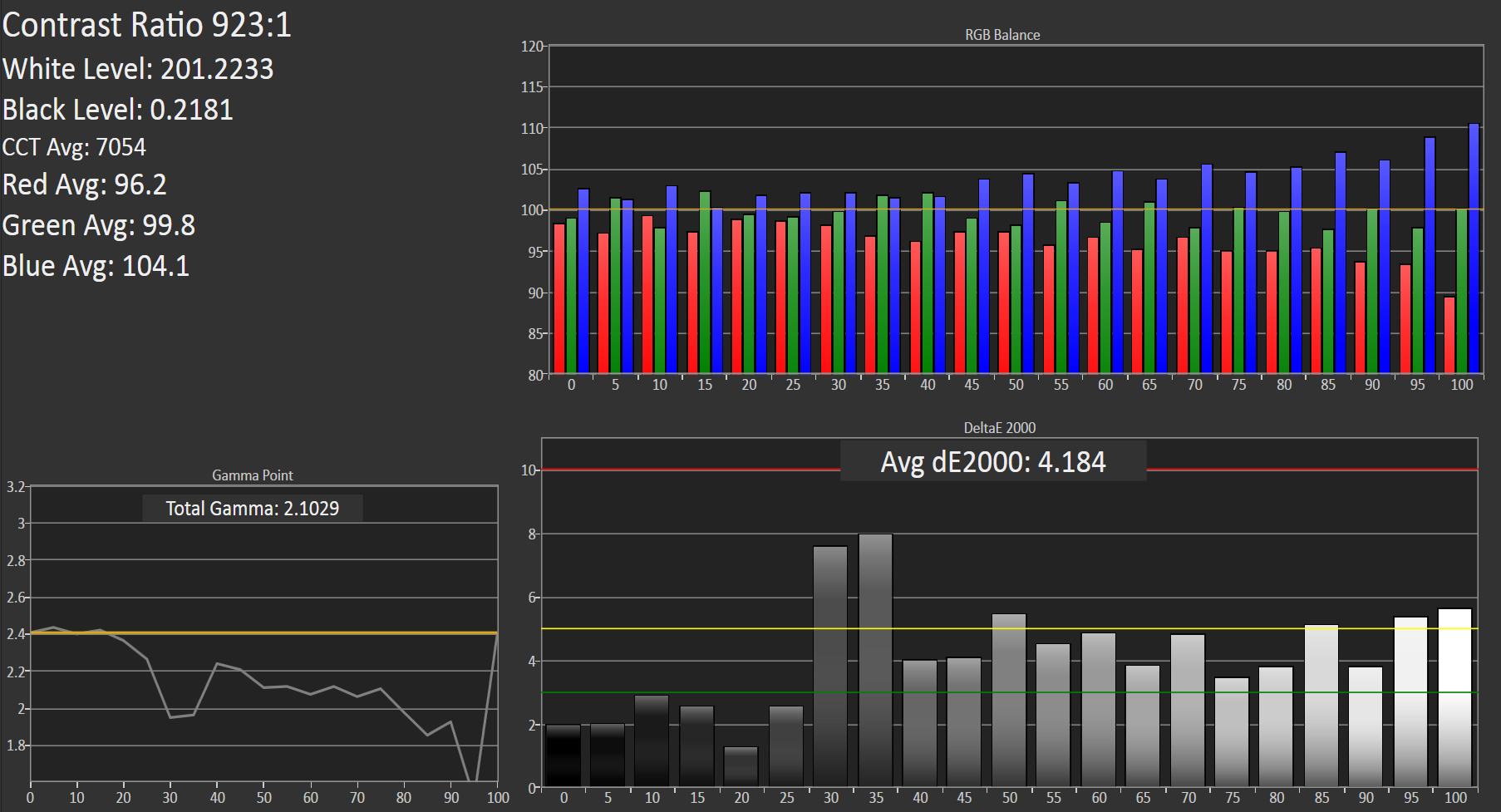








231 Comments
View All Comments
Azurael - Saturday, December 7, 2013 - link
On the other hand, I don't think you could say Android hasn't matured fantastically over the years. I've been a fan since the start (G1 > Desire > Desire Z > Atrix > SGS2 > One X > Nexus 4) These days, I look forward to using Android more than any other platform I interact with on a daily basis... Even 1.5 on the G1 felt like an upgrade from the busted original iPhone it replaced (maybe not graphically, but certainly functionally - Notifications and Copy/Paste!) And I really wouldn't want to use anything pre-ICS these days.And not being a fan of wine, I'd take an Android device any day over the offer of a glass of super priceless vintage wine :)
blackmagnum - Thursday, December 5, 2013 - link
When will Google owned Motorola get a chance to build a Nexus? I'll be looking for a different design language than the Koreans.mrdude - Thursday, December 5, 2013 - link
Never, I hope.The Moto X has some really innovative ideas that are unlike any other phone in the market. I think that phone showed that Motorola is aware that there's a lot more to a great smartphone than just bumping up specs and PPI. The Nexus line, at least to me, seems to be about providing a stable platform to push out Android releases and offer a clean and conservative platform to build upon or strive for. A Moto version of Nexus would likely be just another boring smartphone, which is what I find most Nexus phones to be - great phones, sure, but really boring :P
Thanks for the review, Brian. Looks like I'm pulling the trigger on the Moto X for roughly the same price
usama_ah - Thursday, December 5, 2013 - link
Completely agree. For a while I wanted a Motorola Nexus but after the Moto X I am happy with Motorola doing their own thing because they've been doing a great job. If anything it would be nice if the two camps (Moto and the Nexus team) learned from each other.Wolfpup - Thursday, December 5, 2013 - link
I'm fine with the Moto X *IF* it's supported roughly as fast and long as the Nexus line. I figure the Moto X might be, as it might sort of be an unofficial Nexus, given it's supposed to be pretty clean android, and is technically FROM Google.I wouldn't touch anything else with a 10 foot pole. Gross 3rd party goop on top of the OS, and if you're lucky you get one OS update, and then it's 8 months late (but hey, that's okay, malware writers are good about waiting for everyone to update before they attack, it's just good sportsmanship).
The goop Samsung and the rest slop on top of Android reminds me of the bad old Windows 3.1 days, although with Windows 3.1 at least some of the ideas there were interesting, and you could revert to the real interface.
Pr3ch34r - Thursday, December 5, 2013 - link
As long as the nexus line, is that a joke? I just sold a less than 2 years hold Galaxy Nexus that won't even see 4.4, even Samsung devices last more wrt upgrades...Pr3ch34r - Thursday, December 5, 2013 - link
Hold = old, pls excuse this keyboardElrando Horse - Friday, December 6, 2013 - link
Please point me towards the 2011 Samsung phone getting the Kitkat upgrade.redundant - Friday, December 6, 2013 - link
the beauty of the nexus line is how damn easy it is to install a custom ROM with 4.4. i know that the average user wouldnt be interested in installing a custom rom, but then again nexus buyers usually arent your average folk.Azurael - Saturday, December 7, 2013 - link
Erm, since the design language is from Google, I'm not quite sure what you're hoping for... Does the Nexus 5 look like the G2? No, it doesn't. Does the Galaxy Nexus look like the SGS2/3? No. The Nexus 4 looks more like the Optimus G than the others I've mentioned with it's sparkly glass back, but it's still more Google than LG given the hardware platform is the same! What have you got against Korean design anyway? It's not like anything Motorla have produced since the original RAZRs could be regarded as stylistically interesting... All smartphones look pretty much the same, it's just something we're going to have to grow to live with. A big slab of glass with a speaker at the top and a mic at the bottom is just that, and you can't really deviate too far without hampering ergonomics.